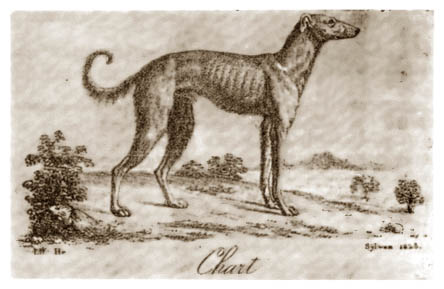 |
Hunting
with sighthounds and combinations of sighthounds and falcons was a popular
sport among the nobles in Medieval Poland.
Translated
from a Polish book by Stefan Blocki: |
 |
Hunting
with sighthounds and combinations of sighthounds and falcons was a popular
sport among the nobles in Medieval Poland.
Translated
from a Polish book by Stefan Blocki: |
In Poland, the sighthounds were already known in the 12th Century, probably even before. They were part of the commerce with the peoples of Asia. The first mention concerns the expense of the royal kennel where they kept different coursing dogs and indigenous sighthounds, this is found in the chronicles at the castle of Wawel in Krakow. The practical study of the skulls of representatives of each of these breeds demonstrates a resemblance and likely parentage of the Saluki and oriental type sighthounds for the Chart Polski. The results of these researches were published in a thesis by the Principal School of Agriculture in Warsaw. They were also the basis for the establishment of data for the standard.
Successive mention dates to a colorful and tragic period in Polish history, the 16th and 17th Centuries; and provides written data concerning the aspect, maintenance and hunting with Charts. This is detailed in the book,"Riding and Hunting" published in 1690, by Gostomski.
The Chronicles of 1823, are relevant in that among the dogs one meets on the course, one found mention of the "ordinary sighthounds" or "our indigenous sighthounds". This proves that the dogs were already known at that time, and their aspect was frequently homogenous. They were considered a numerous breed, indigenous, existing for quite a long time. The authours of these chronicles also in effect distinguished between them, the Deerhounds and Greyhounds. In the chronicle of Sylwan, of 1823, one finds a drawing of the Polish Sighthound. (shown below) All of these describe the dog as a big, powerful sighthound, with a somewhat longer coat than the other shorthaired sighthounds. The dogs were used to hunt not only hare, but also fox, wolf and bustard, a large crane-like bird.

The Polish works of art specializing in hunting scenes of horsemen also represent the Polish Sighthound. A meticulous and detailed presentation of the costumes, historically faithful, and of good proportions, prove that the aspect of the Chart Polski has been accurately reproduced. The dogs represented in the works of Juliusz Kossak (1868) and Jozef Brandt (1883) were large, well muscled and well propertioned, with the typical coat, longer on the backs of the thighs and on the tail.
One example which illustrates the passion for hunting of the nobles and the efficiency of the dogs is found in a fragment of the poem, "Pan Tadeusz" by A. Mickiewicz (1834) known by all the Polish, which decribes the bet of two owners of sighthounds on the coursing of a hare by the dogs. Because of the size of the territory of old Poland, the dogs differentiate a bit from one another. Living and hunting out on various terrains, the dogs of central Poland were smaller and lighter, those of the territories of Podole larger and stronger. This type of difference you will also see amongst the current dogs of France.
There
have also been some references about the breed in Russian writings:
From
the book, "Hunting Dogs" by Leonid Sabaneev:
In the
beginning of 18th century, the Russian hunters crossbred different sighthound
breeds (English, Polish, bearded) between each other and with the Russian sighthound.The
crossbreeding of English and Polish sighthounds with Russian sighthounds, especially
after the Napoleonic wars, created another type of Russian sighthound, which
was named Chistopsovaya.
Baron
G.D. Rozen, 1891 tells about "interbreeding" the long-haired Russian sighthounds
and the bearded, and the Polish sighthounds...
He describes
the correspondence between Saltykov and Volynskii
where
Saltykov asks Volynskii to send him a bearded bitch for mating with the
short-haired
male of the Polish ambassador Count Zawisz, and Volynskii then
writes
to Saltykov about the bitch "Tatarka", evidently a Crimean.
In
his chapter on "prehistoric period" Rozen presents a theory that the
sighthounds
originally came into Russia with the Aryans from Central Asia,
and
their sighthounds mixed with the local dogs, producing sighthounds
with
"semiprick ears".
Xavier
Przezdziecki, in his book, "Le Destin des Levriers", 1984 (the Fate of the Sighthounds)
says
that it's possible that at the time when theVertragus was being developed into
the Greyhound in the British Isles, the same Vertragus might have been developed
into a larger, more robust dog in the harsher climate of Poland.
Unfortunately
during the late 19th Century after many political and economic upheavals in
Poland and the surrounding areas, and the fall of the large landholders, hunting
with the sighthounds was becoming impossible. The World Wars in our century
nearly wiped out the breed completely, and only a small number remained in kennels
in Poland, and in a part of Ukraine. (which was once part of Poland)
Contemporary history of the Chart Polski.
Chart Polski in the works of Juliusz Kossak, a 19th century Polish painter.